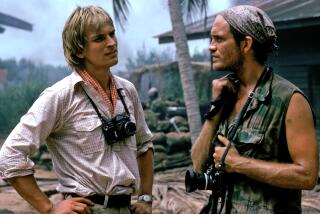Most of Barbara Stanwyck’s Finest Performances Available
- Share via
Most of the best movies of veteran screen star Barbara Stanwyck, who died last week, have been released on video.
The bulk of her quality movies were made between the late ‘30s and the mid-’50s. Here is the cream of that period--all available on cassette:
“Stella Dallas” (Nelson, 1937). In one of the great no-holds-barred soap operas of the 1930s, Stanwyck plays a good-hearted, lower-class woman who consistently puts her daughter’s happiness ahead of her own. Stella’s unsophisticated ways--and horrible taste in clothes--ultimately cause her social-climbing daughter (Anne Shirley) much consternation. Of the great self-sacrificing heroines, Stella is in a league with the Gladys George’s suffering character in the 1937 version of “Madame X” and Bette Davis’ spinster in “The Old Maid.”
“The Lady Eve” (MCA, 1941). One of the two or three best movies by writer-director Preston Sturges. In this hearty romantic comedy, Stanwyck, flashing impeccable comic timing in early scenes, plays a card-shark who works the ritzy ocean-liner circuit, fleecing wealthy passengers. Her prize prey is a shy millionaire (Henry Fonda). However, her con job goes awry when she falls for her pigeon.
“Ball of Fire” (Nelson, 1941). In director Howard Hawks’ fast-paced, screwball comedy, Stanwyck stars as a tough-talking burlesque dancer who, while running from the police, moves in with a group of stuffy professors who are working on an encyclopedia. Of course, she falls for one of the scholars (Gary Cooper). Even the out-of-control, slapstick ending doesn’t really spoil this one. One of Stanwyck’s comic peaks.
“Meet John Doe” (Media, 1941). In one of director Frank Capra’s more sentimental homages to the common man, Stanwyck forcefully portrays a cynical, conniving reporter who hatches a plan to turn a naive drifter (Gary Cooper) into the leader of a national grass-roots movement. But a corrupt politician (Edward Arnold) plots to use the scheme for his own devious purposes. Brimming with wartime idealism and cornball Americana. Cooper’s performance is really the heart of this movie.
“Double Indemnity” (MCA, 1944). One of the best of the hard-boiled ‘40s melodramas. Stanwyck plays a scheming wife who plans, with a smitten insurance agent (Fred MacMurray), to kill her husband and collect the insurance. The major obstacle is the agent’s clever boss, played by Edward G. Robinson. As good as Stanwyck is, she is overshadowed by MacMurray, who gives the best performance of his career as the man led astray by illicit passion. The script was co-written by detective novelist Raymond Chandler.
“Christmas in Connecticut” (MGM/UA, 1945). This is the wrong season for this one, but so what? Stanwyck stars as a columnist who, to save her job, has to arrange a cozy Christmas in Connecticut for a soldier (Dennis Morgan). Though one of her more obscure movies, Stanwyck’s chemistry with Morgan transcends anything generated with Gary Cooper and Henry Fonda in more famous romantic comedies.
“The Strange Love of Martha Ivers” (Kartes Video and Congress Video, 1946). Terrific performance by Stanwyck as Ivers, a rich, powerful temptress with a shady past. Her husband (Kirk Douglas, making his film debut) capitalizes on her dark secret. One of the best evil-woman roles of her career, but this one is usually neglected by fans and historians in favor of her work in “Double Indemnity.”
“Sorry, Wrong Number” (Paramount, 1948). This showy, somewhat overwrought performance was her last good shot at a best-actress Oscar but she lost out to Jane Wyman in “Johnny Belinda.” Stanwyck plays an obnoxious, bedridden woman who torments her husband (Burt Lancaster). Overhearing a murder plot on the phone, she figures out that she’s the target.
“Executive Suite” (MGM/UA, 1954). Taut, well-written, star-studded drama of corporate in-fighting, co-starring William Holden, June Allyson, Fredric March and Shelly Winters. Stanwyck is effective in a relatively small role as a pivotal stockholder, but it’s really Holden’s movie.
The best of rest on video:
“Golden Boy” (RCA/Columbia, 1939). Notable as William Holden’s debut as a leading man, but he is guilty of overacting (as are Stanwyck and Lee J. Cobb) in this tale of a young man who choses boxing over a career in music. Clifford Odets’ dialogue now seems laughably overripe.
“Lady of Burlesque” (Video Yesteryear, 1943). Lively suspense comedy about the search for a killer who is strangling strippers with their own G-strings.
“Clash by Night” (United, 1952). Moody love triangle with Stanwyck effectively playing an unhappy wife. Co-starring Paul Douglas, Robert Ryan and, in a secondary role, Marilyn Monroe. Very hard to find in video stores.
“Blowing Wild” (Republic, 1953). Underrated, steamy action-adventure tale about another love triangle involving an oil baron (Anthony Quinn), his wife (Stanwyck) and her ex-lover (Gary Cooper).
“Cattle Queen of Montana” (Buena Vista, 1954). The best thing about this routine Western, featuring Stanwyck as a powerful rancher battling Indians and crooks, is the spectacular scenery. But it’s infamous because it boasts possibly the worst performance in the career of co-star Ronald Reagan.
“The Maverick Queen” (Republic, 1955). Rousing action Western about a feisty bad girl (Stanwyck as a saloon owner) falling for a good-guy lawman (Barry Sullivan).
Not yet on video but worth seeing if and when available:
“The Bitter Tea of General Yen” (1933), “Always Goodbye” (1938), “Union Pacific” (1939), “The Two Mrs. Carrolls” (1938, co-starring Humphrey Bogart), “The Furies” (1950), “All I Desire” (1953), “Witness to Murder” (1954), “The Violent Men” (1955) and “There’s Always Tomorrow” (1956).
More to Read
Only good movies
Get the Indie Focus newsletter, Mark Olsen's weekly guide to the world of cinema.
You may occasionally receive promotional content from the Los Angeles Times.










